mouse
over and click on Masthead to go to
Organizational transformation
Paper |
20
years, Graphics, Modeling Transformation |
| The
pictures and graphics that make up this Masthead
span 20 years. The picture of
me at a WorkWall was taken in 1985 - I was 47
at the time and we had just left Acacia and were
starting iteration4 [link] of
MG Taylor’s history. The two Abscapes studies [link], Hierarchy and
Quo Vatus, were drawn by me in 1987. My
picture, in the orange sweater, was taken at the
WEF Annual
Meeting
this last January. 2005 [link],
the powering up time of iteration6
[link] of
MG Taylor’s evolution.
This masthead evolved, as is described below, as
a reminder that you cannot take yourself out of the
process
of organizational transformation nor can you avoid
the personal consequences of it. The Transition
Manager [link] [link] is
not immune from the process nor from the personal
consequences of it. |
| Each
of the Masthead’s components have both denotative
and connotative meaning. Each contain memory [link].
Each has a spatial relationship to each other which,
itself, is content. Together, they
illustrate
a process
and tell a story. The story has many aspects; it
is one telling; it is not the whole of it but, like
a hologram fragment, it contains it all if only in
partial resolution. The focus of this piece is to
tie together
some personal
threads of my experiences facilitating organizational
transformation and the consequences of doing so.
In do this, the goal is to brings some clarity to
the role of the Transition Manager. |
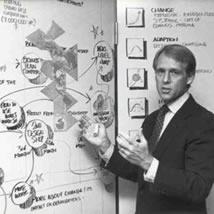 |
| I
am explaining, circa 1985, the MG
Taylor strategy for facilitating organizational
transformation
on a global scale [link]: a ValueWeb
of NavCenters supporting Transition managers
who are
designing and facilitating the emergence
of a better world. |
|
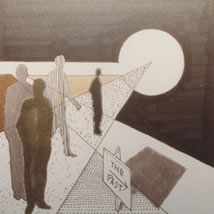 |
| There
are deliberately distorted perspectives
and horizon lines in this 1987 Abscape
study. The size of the people are “wrong.”
The
attitude
is one
of ambiguity and uncertainly. There is
clearly a choice, but the future is no
more certain than the path to the past.
Which way will they go? |
|
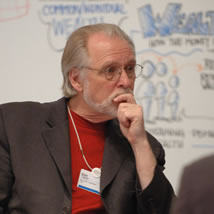 |
| At
Davos 05 wondering what it is all about.
This event should have been
a celebration but circumstances
clouded what was a benchmark occasion
for our work. Perhaps 06 - if there is
one - will see
the practice more fully accomplished.
It is essential to keep this moment in
context of a life-time of work. |
|
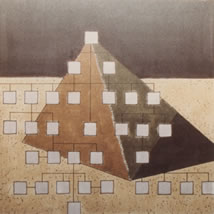 |
| This
side of transformation, the feedback
to our work is from the old paradigm
of organizational structure. “Structure
wins.” This does not mean that the
feedback is all negative. Negative
or positive, the context is from the
Industrial Era and has to be understood
as such. |
|
|
glass_bead_game_4_step_play |
| Playing
the Glass Bead game further, see below, the 4
Step Re-Creative Model is superimposed over
the Masthead graphic.
Through this lens, we can see 20 years of
concept and intent having
gone full cycle. At this 20 year scale and perspective,
a different story emerges than can be told from the
narrower
viewpoint
of a disconnected series of incremental experiences.
In my mind, this illustrates why personal documentation
is so important and how an appropriate modeling language
can be employed to “see” what otherwise
daily experience can so easily miss. Experience without
models to frame it is as inadequate as models without
experience to give reality to them. |
|
| Process
cycles happen on many different time scales. The
Taylor method focuses on rapid iterations of work
and on “shipping a product” each one.
To bring about large scale change and transformation
also requires
paying attention to very long cycles - many of them
generational in length [rbtfBook].
It is as necessary to “ship a product” at
the end of these longer iterations as it is upon
completing
the shorter ones. It is not short vrs long cycles
- it is the integration of both into a NOW that can
be see and responded to as a single system. |
turning_negative_reaction_to_work |
| I
made this Masthead from existing graphical pieces
for a paper on the process of organizational
transformation [link].
This paper is the result of my reaction
to an experience that I had, earlier this year, wherein
I
believed a
corporation
was working hard on “transformation” but fundamentally
approaching it in a wrong way. They had a flawed
model of transformation and were working against
themselves.
It was a classic exercise of some very bright people
working very hard, spending millions of dollars,
and beating themselves up very badly in the process.
They also lashed out at everyone they had asked to
help them in their process. It was all very painful
for everyone - and unnecessary. Worth it, perhaps,
if transformation was to be the result. But, this
cannot be. This work was nothing but a massive exercising
of
the old, entrenched corporate structure and process
on a “head trip” about a future it wants,
intellectually, but will not, yet, allow to happen. TRANSFORMATION is
the consequence of a fundamentally different approach
to the world and if it is not fun - hard work, yes,
but fun - it will not happen. |
| In
January, I posted the two graphic portions of the
masthead right
away because they expressed ideas that I knew I
wanted to talk about. As I wrote the piece, however,
I was re-mind-ed how much transformation
is a personal experience and not something
a corporation and some
consultants can do to a group of people.
Recovering from an extremely stressful and disapointing
three weeks, I stared the Paper on the airplane to
the 05 WEF event and
slowly
pecked away at it during the months afterward. As
my frustration with my January experiences, with
entrenched corporate structures, waned so did my
interest in writing about it. During the June 05 ReBuilding
the Future DesignShop
sponsored by AoGG, TomorrowMakers and MGT, Gail and
I talked about the role of the Transition Manager [link] and,
of course, sought to put the process of organizational
transformation into the context of time. It was with
this expereince that I decided to put myself (with
the two pictures, 20 years apart) into the Masthead. |
| Superimposing
the 4 Step ReCreation Model onto the Masthead transforms
the picture. This, however, requires an understanding
not only of the Model, itself, but its history. The
comments
below provide a brief outline of both. |
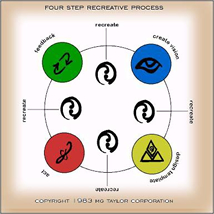 |
THE
MODEL is
divided into 8 steps. Four of these are states
of activity each a manifestation of an idea.
Each is a transformation of the idea as it
is expressed
in a media. In between each of these states
is a death and rebirth process - the recreation
necessary for the idea to be expressed in
a new and fundamentally different form.
|
|
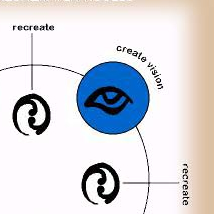 |
| The
FIRST STEP is to conceive of an idea/design
in the multidimensional multimedia, high
variety, timeless, space that is the mind.
On the human level of recursion, rL4 [link],
this is an individual act. The mind-media
holds an enormous complexity, over
extend
time, and the idea/design can easily mutate
within this space. This is incubation. |
|
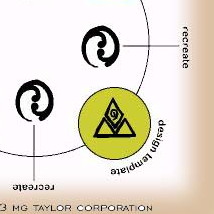 |
| The
SECOND STEP is to put the idea/design into
some form outside of the self. This form-environment
will have structure (and conventions)
that will effect the design of
the idea be
it a
web site,
a book, a paper, a drawing, a speech, or
a physical model. In all cases, this involves
a radical reduction in variety and can only
produce one expression of the idea. |
|
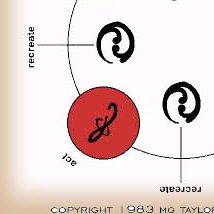 |
| The
THIRD STEP takes the TEMPLATE created in
the second step and actual manifests the
idea/design in concrete form causing
an enormous increase in variety from the
“paper’ expression of the concept which is
two dimensional and linear. This is why it
has be be recreated just as the transition
from Step One to Two required - the idea
in in a new form. |
|
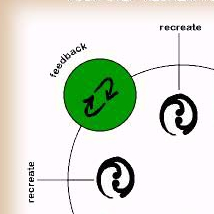 |
| The
FOURTH STEP is to evaluate the experience
of the first three steps and to provide feedback
to the Idea/design - not to what was built
as is commonly thought. What is the idea/design
now? Once again there is a recreation
as you move from a user of your
creation back to being the author of its
next cycle of
development. |
|
origin_and_purpose_4_step |
| I
created this Model out of a personal frustration
and a question. The frustration was how to
“pass on” a vision to others
so that it is not destroyed yet in a way that they
can invest their own genius and
creativity to it. This is a fundamental question
of GroupGenius and the creation of large-scale,
complex works of great
integrity and art. This Model allows for multiple
expressions of the idea as it moves through the Stages
and as it is recreated in different media. Different
people with different skill sets and ideas, make
up and employ that new media. The question was how
was it that so many people had difficulty
in
“moving”
a
concept
through the creative process as it developed from
an abstraction through various concrete expressions
of the Design Formation [link] Model.
I do not have difficulty with this task. What was
it that
I do differently than others and how do I think
about and conduct this process? |
4_step_relationship_to_solutionbox |
| By
the time I developed this Model, the Creative
Process [link],
Design Formation and Vantage Points [link] Models
were long established and well embedded into our
work process. These three Models make up the SolutionBox Model
which you see at the bottom of every one of my articles
on this web site. This model provides a 7 x 7 x 7
matrix of the steps an idea moves through from
concept
to
use. Each of these way-points can have an agreed
upon language and standards of credibility (to a
community
of practice) - this make individual and group navigation
possible. The 4
Step [link] model
is not another restatement of the other three. It
is aimed at getting
at what
happens - or not - at the transition points
in the creative process be that when thinking moves
from
one stage
to another, when the work product takes on a
new form, or when the work itself is introduced to
a new community of co-designers. It is at these transitions that
there seems to be the greatest propensity for confusion
and when the environment, in which the work
is done, is most likely to
be compromised causing unnecessary delays and degradation
of result. |
dealing_with_variety_shifts |
| This
model deals with two aspects of complex, distributed,
time stretched creative projects. First, the process
of getting an IDEA translated
into documented, and ultimately, built form.
If you realize that the idea has to be completely
recreated each transformation it takes and that this
is because of the variety equation [link] and
the media in which the idea is rendered, then, the
real
task is revealed. If you have an idea of a house
in your head, for example, and try to draw what is
in your head - you will fail. If you understand that
you have to render it in a new, constrained,
lower variety, media, then you can succeed. The same
is true moving from the
template of a
drawing to building. If you just build what
is on paper, the result will fall short of its full
potential.
The media and complexity of a built thing (involving
many contributors and a higher variety) is always
far greater than what a piece of paper (no
matter
how well done) can hold. Second, the process of engaging
others in a VISION which
they can make their own by working in it
and bringing their special genius to it,
thus, helping to both recreate it and manifest it.
It is at the Recreation Points that allow
this to be done without doing violence to the work
that came
before. The act of re-creation not
only is a good time to bring new members to the effort
it is
absolutely necessary for success. The act of recreation
is the creative act and the entire creative process
has to be completed at each of these transition points. |
| Writing
this Article has been part of my personal “debriefing” process
of the ReBuilding the Future DesignShop
event [link] and
was started concurrently with writing the final Scenarios
to the Bad Ragaz Private Wealth Council Workshop [link].
As I prepared for and, with Gail, facilitated the
Bad Ragaz Workshop, I worked in this Notebook to pull
together many aspects related to the last 6 months,
specifically,
and the last 20 years, generally. This introspection
has remained a continuing process from
my working retreat in February of this year (and
the immediate time leading up to it) which was documented
in my Notebook #7, post 9/11 series [link] -
most of my retreat comments are on the left hand
pages from p. 529 to the Postscript of this hand
written Notebook [link]. |
transition_manager_in_two_worlds |
| The
transformation
of organizations and societies is personal.
The Transition Manager [link],
has to bridge both the new and old worlds; s/he has
to be competent in
both and independent of both. In terms of
the organization or community s/he is facilitating,
s/he has to be
in this world but not of it. Not
only is s/he a fiduciary and must avoid entanglement
and
improper gain, s/he has to be aware that, at critical
moments, the old world in transition may attack agents
and agencies [link] of
change - this includes the Transition Manager. This
risk is an unavoidable aspect of the role and of
the work - it has to be
accepted.
The Transition Manager’s response
to the
attack
is critical, in the transformational process; the
response has to be neutral and objective. If the
Transition Manager is pulled into the game, all can
be lost. Transition management is meta-facilitation
on extended organizational and time scales. |
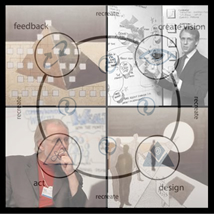 |
| Over
the 20 year “story” depicted by this Model,
I started out an advocate of change (1), built
a Method to facilitate change (2), became,
sometimes reluctantly, a Transition Manager
(3), and now I am evaluating these experiences
in light of the still-in-place social structure.
We have to have Transition Managers. How do
we facilitate their work? |
|
| To
get more depth on the 4 Step Model,
and how it brings insight to the 20 year cycle,
a study
of the glyphs is useful. Check out the definition
of these glyphs on the MG Taylor web site [link] and
then read the additional notes below and click
on the glyphs for links that add context to
the story. |
|
 |
| At
the time my picture was taken explaining about
a network of NavCenters, the idea was already
over fives years old - a map (template) had
been drawn. |
|
 |
| The
WORK has reached a threshold that will require
a far greater community and ValueWeb than has
existed before; we are at the step-function. |
|
 |
| The
work of MG Taylor is truly global now in terms
of where it is done, the diversity of people
it reaches and the web publishing of the results. |
|
 |
| You
cannot fix the past. Even if you “go back”
to “fix” something it is a new act.
What does the
VISION of a global network of NavCenters
mean in 2005? |
|
 |
| iteration6
will be the greatest change MG Taylor has ever
experienced - the transition from an organization
to a true, functioning ValueWeb. |
|
| There
is no question that many of us, associated
with MG Taylor, have paid a high price to bring
this new way of
working
into the world. Yet, we have stayed true to
our mission
[link] no
matter the circumstances. I have always been
an idealist and see no reason to change now
[link] even
if the score is sometimes discouraging - the
game is not over; the game is never over
as long as there remains life. |
| A
global transformation is an unbelievable big
undertaking. It cannot be understood or controlled.
The conditions necessary to better facilitate
it are possible to understand and create. That
is what this work is about. It can only be
done in a series of concrete steps [link] that
are done in a global and long term context
- you cannot change the world by directly trying
to do so. You can add to the storehouse
of options [Fuller].
And, you can be an exemplar, of better choices
[Gaundi].
You can engineer and build better solutions
[mcdounugh].
It is possible to do this and lead a balanced
life [link]. |
| The
practice of the Transition Manager is to create
these conditions and facilitate a local community
in their part of a Global outcome. It is as
simple as that. |
|
|
| It
should be understood that not everyone should attempt
this role; and, that there are many other roles that
are equally important - the “conservative” who
holds the integrity of the old ground and the “advocate”
who agitates from the new, make two examples. If
the TM role is to be performed, however,
there are certain rules necessary to the
role and
certain
expectations that have to kept in mind and practiced
with total integrity else the work fails. These are
outlined in the Transition Manager’s CREED:
keep a balance between the two worlds with a competent
foot firmly placed in both; while holding Enlightenment
Principles, do not bias the outcome in the specific;
do not take unfair advantage of the situation (fiduciary
stance). Facilitate, as well as design. |
| When
any of us are employing the Taylor Method for a client,
or as a facilitator/KnowledgeWorker for our own organization,
we are acting as a Transition Manager. We may have
other roles outside of this specific task. Some,
may choose to function as a Transition Manager in
all
the
work that they do be they employing the Taylor Method
explicitly or not, working with a client or not.
I believe, that just as the Knowledge Worker [Drucker] is
becoming seen as a legitimate role, so will the
Transition
Manager as the moment of large scale and disruptive
social transformation gathers momentum. It will be
necessary to codify this role and to train for it
as it will for the Fair Witness [Heinlein] and Speakers
for Gaia [link].
These issues operational will be taken up elsewhere. |
| Even
into the early 60s, there remained the notion of
the “public person” who took on the role of public
stewardship. Servant Leasership, by Greenleaf [rbtfBook],
explores many aspects of this role. I am sure that
there remains
such people but they are
drowned
now
in controversy,
spin,
litigation
and partisan politics. It should be remembered that
such an environment is actually an advantage to those
who command great resources and seek illegitimate
power. Always “follow the money” and ask “who gains”
in
what looks
like a ridiculous, random situation. There were times
when churches, universities and governments severed
the creation of the public commons - no longer with
rare exception. We, as a society, have to decide
what kind of
social space we want to live in - perhaps, if present
trends
continue, can live
in. To do this we will have to embrace better rules
in regards how criticism is conducted [link].
And, we will have to create new socially accepted
and properly credentialed roles such as the Knowledge
Worker, Transition Manager, Fair
Witness and Speakers
for
Gaia. Failing to do this, we find ourselves
in a social quagmire impossible to navigate, devoid
of the practice of philosophy [link] and
left to those who, driven by only un self-examined
ambition to exploit everything in sight [link] and
turn every thing and everybody into a commodity. |
| The
Transition Manager plays a key role in the creation
of this space. The Taylor Method starts with
the creation of a neutral space [link] which
contains a level playing field for those who will
risk the
exposure necessary
for the emergence of GroupGenius [link].
This SPACE is composed of spiritual, energetic,
philosophical, informational physical, technical
and process elements designed to facilitate the emergence [link] of the best that people have to offer themselves
and the world. |
| Those
who take on Transition Management will give
up many amenities that our society bestows on talent
applied
to popular project within “proper” channels; s/he
will risk retaliation and sometimes serious attack.
This role requires years of intense preparation and
continual self-evaluation [link].
This commitment does have rewards. The work is honest,
the results often gratifying and sometimes it pays
very well. |
| It
is not for everyone. If it is for you, and we can
make common cause, contact [link] me. |
| If
you are interested in the application of philosophy
to the real world, I recommend that you check out
the American Philosophical Practitioners Association
[link].
Here is a group who is working across the grain of
the current love-in with nihilism and the
assault by the deconstructionists. Philosophy is
important - as we find out (sometimes to our regret)
a generation later. I mention them here becuase they
do 3-Day Certification Training Program for Philosophical
Counselors. This is very much in the spirit of the
roles I outlined above. |
|
|
|
| Return
to Matt Taylor Papers Index |
|
|
|
|
|
| GoTo
ReBuilding the Future Reading |
|
|
|
Matt
Taylor
Liechtenstein
June 20, 2005
|

SolutionBox
voice of this document:
VISION • STRATEGY • EVALUATE
|
posted:
June 20, 2005
revised:
June 29, 2005
• 20050620.651999.mt • 20050621.455420.mt
•
• 20050625.432198.mt • 20050528.121415.mt •
• 20050629.900879.mt •
(note:
this document is about 95% finished)
Copyright© Matt
Taylor 1985, 1987, 2005
|
|
|